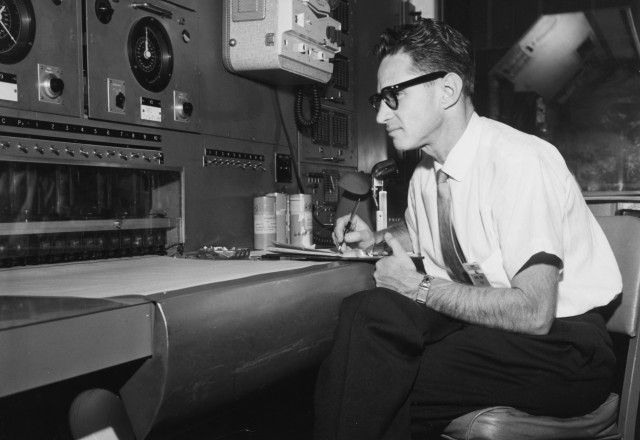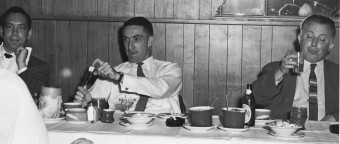
We all know the image of the aerospace engineer. Short-sleeved white shirt, skinny dark tie, crew cut, horn-rimmed glasses, pocket protector. Think Michael Douglas in Falling Down, the 1993 movie that followed Douglas’s character, a laid-off aerospace engineer, on a violent spree across Los Angeles.
There is some truth to the image. A new archive on the history of Southern California aerospace, a collaboration between USC and the Huntington Library, has abundant photos confirming the stereotype: earnest young engineers of the 1940s and ’50s bent over drafting tables in full nerd regalia, slide rules at the ready. But the archive also suggests a more interesting reality.
Consider Al Hibbs, whose papers recently arrived in the aerospace archive. As a young mathematician, Hibbs calculated probabilities in Las Vegas casinos and sailed the Caribbean for a year on his winnings. (Along the way, he trapped alligators to sell to zoos.) He went on to earn a Ph.D. in physics at Caltech and to help design the early space program at NASA’s Jet Propulsion Laboratory. He also popularized science on radio and television, flew sailplanes, invented an electronic trombone, applied to the astronaut corps, acted in local theater, and pursued underwater photography and kinetic sculpture.
Hibbs may be an extreme example, but Southern California aerospace abounds with ostensible nerds who designed new ways of having fun when they weren’t designing airplanes and spacecraft. Bob Simmons, a Caltech engineering student who moonlighted at Douglas Aircraft during World War II, applied aircraft materials–fiberglass, polyester resins, polystyrene foam–and advanced hydrodynamics to revolutionize surfboard design. A couple decades later, another aerospace engineer, Tom Morey, combined his knowledge of advanced aerospace composites with a quirky sensibility to invent the Boogie Board; another aerospace engineer at the Rand Corporation invented the windsurfer. And so on.

The mid-century aviation plant was a microcosm of Southern California in its diversity and in its collection of energetic individuals. Test pilot-engineers at Edwards Air Force Base rode horses when they weren’t riding rocket planes. Women flooded the aviation workforce during World War II, as the celebrated “Rosie the Riveter.” The male-dominated engineering profession largely hindered women’s opportunities as engineers until more recent decades, but in the ’50s aerospace heyday women played important roles as “computers”–doing the math and calculations necessary to build planes and rockets–before electronic machines replaced them.
During the 20th century, millions of people flooded Southern California for aerospace jobs; dozens of airfields dotted the landscape; test-rocket firings flashed and echoed in the foothills; and the local economy became yoked to the boom-and-bust cycles of defense spending. In the process, aerospace helped drive the extraordinary metamorphosis of California from a rural, agrarian state to the sixth-largest economy in the world.
Southern California aerospace not only reshaped the region; it changed the world. Its technologies underpinned U.S. national security, from propeller-driven airplanes and bombers in the World Wars to strategic missiles, reconnaissance planes and satellites, and stealth aircraft in the Cold War. Meanwhile, its commercial aircraft and then communications satellites connected distant continents and cultures, propelling globalization. Finally, Southern California’s fundamental contributions to the civilian space program, including the moon landings and the robotic exploration of the solar system, challenged and transformed the human imagination.
All the aerospace workers who made these innovations possible–hundreds of thousands of them, for much of the Cold War–helped ferment the heady brew of Southern California culture, from water sports and hot-rodding to architecture (William Pereira’s aerospace buildings), literature (from science fiction to Thomas Pynchon and Joan Didion), and design (Charles and Ray Eames).
A just-opened exhibition at the Huntington Library, “Blue Sky Metropolis: The Aerospace Century in Southern California,” presents some first fruits from the archive. It also highlights the fact that the history of Southern California aerospace is not just about the technologies of aircraft and spacecraft, although these represented some remarkable engineering achievements. Rather, the history is also about the people who built these things, what they did both on and off the job, and how they lived their lives here in Southern California.
That brings us back to Al Hibbs. On a Caribbean sailing trip in 1982, when Hibbs was pushing 60 years old, he remained an avid participant in boat races.
Not sailboat races, mind you. Rather, the “boat races” familiar to any college student: you take two rows of people (in Hibbs’s story, men versus women), give each one a beer (here, Guinness Stout), and go down the row: as soon as the first person has downed his beer, the cup goes upside down on top of his head, and the next person starts guzzling. First row finished wins. In this case, the first mate ruled the women had won, only to be overruled by the (male) captain, who exercised his prerogatives and, Hibbs recounted, “gave the prize to the boys.”
“But then,” Hibbs concluded, “it’s not whether you win or lose, but how you play the game.”
Matthew Hersch is lecturer in Science, Technology and Society in the Department of History and Sociology of Science at the University of Pennsylvania. Peter Westwick is director of the Aerospace History Project at the Huntington-USC Institute on California and the West and assistant research professor in history at USC. The Blue Sky Metropolis exhibit runs through January 9 at the Huntington Library.
*Photos courtesy of Matthew Hersch and Peter Westwick




Send A Letter To the Editors